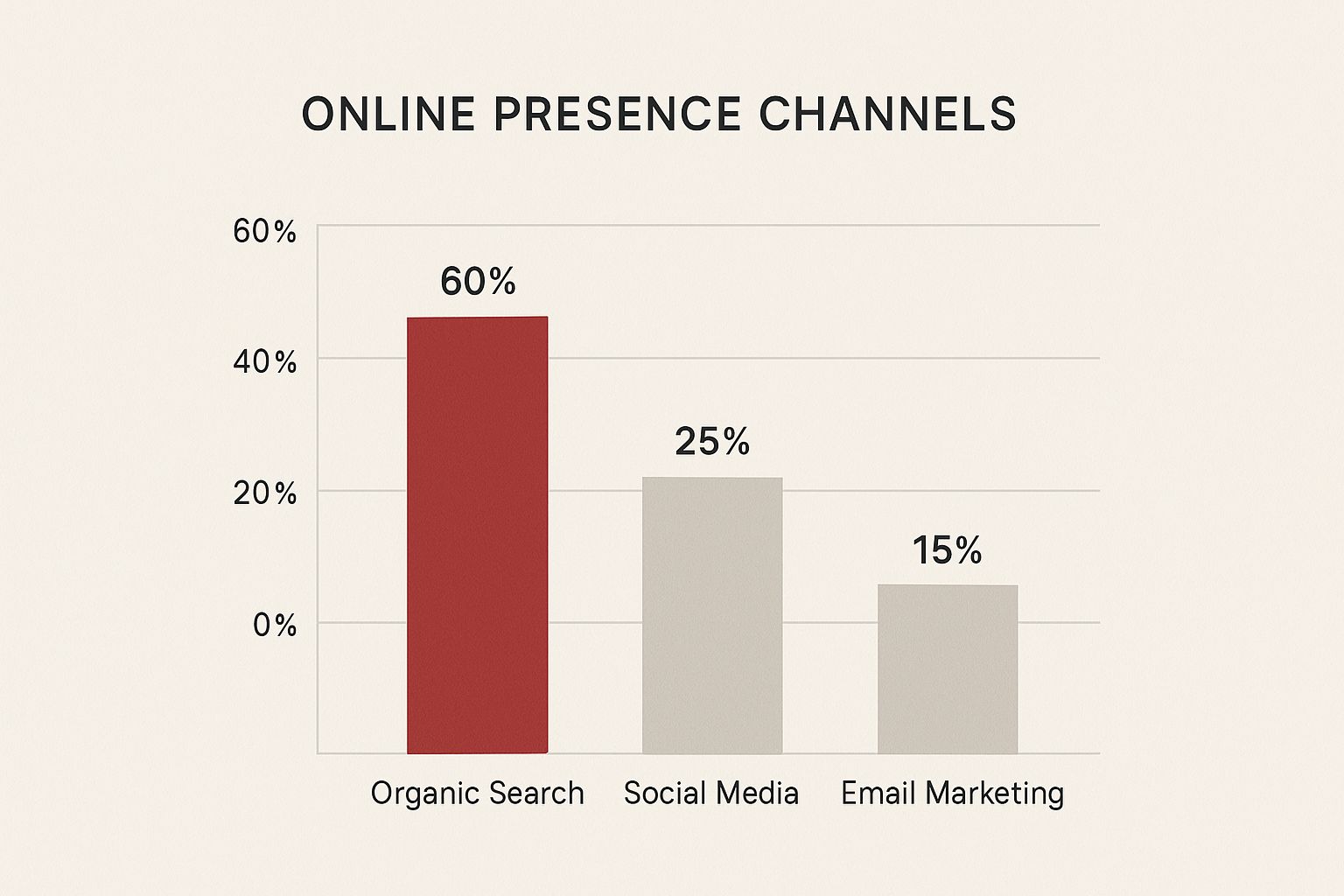Let's be blunt: most startups don't make it. The reason is rarely a bad product. More often, it's a failure to connect with the right audience, and that’s where digital marketing becomes your single most important tool.
Think of it like this: your startup is a beautifully designed car, but digital marketing is the engine. Without it, you’re just sitting still.
Why Digital Marketing Is Your Startup's Engine for Growth
For a new company, marketing isn't just another department—it's the lifeblood that connects your brilliant idea with the people who actually need it. It’s how you build something from nothing. You don't have a big brand name or a loyal customer base to fall back on. You have to earn every single click, view, and sign-up.
This guide is your practical roadmap, designed for founders who are stretched thin on time and money. We'll skip the jargon and get straight to the high-impact strategies you can start using today. Our goal is to help you build a marketing flywheel that spins up awareness, pulls in users, and fuels real growth from day one.
The New Reality of Reaching Customers
The days of relying solely on traditional advertising to make a splash are long gone. Today's marketplace is overwhelmingly digital, and the numbers don't lie. Online channels now command a staggering 72.7% of worldwide ad investment, a figure that crossed the $790 billion mark in 2024.
This isn't just a passing trend; it's a fundamental shift. Just a decade ago, digital was a much smaller piece of the pie. The pandemic slammed the accelerator on this change, and there's no going back. What does this mean for you? It means your customers, whether they're other businesses or individual consumers, are online. And that's exactly where you need to be.
Digital marketing levels the playing field. A smart startup on a shoestring budget can absolutely outmaneuver a larger, slower competitor by being more creative, agile, and data-obsessed.
To get started, it helps to see the core marketing activities as interconnected parts of a growth engine. Each component has a specific job, but they all work together to create momentum.
The Startup Marketing Flywheel Key Components
Here’s a quick breakdown of the core digital marketing pillars every startup needs to think about for sustainable growth.
| Marketing Pillar | Primary Goal for a Startup | Example Tactic |
|---|---|---|
| Content Marketing | Build trust and authority | Writing in-depth blog posts that solve a customer's problem |
| Search Engine Optimization (SEO) | Get discovered by people actively looking | Optimizing your website for keywords your audience searches for |
| Paid Advertising (PPC) | Drive targeted traffic quickly | Running a Google Ads campaign targeting specific user demographics |
| Social Media Marketing | Build a community and engage directly | Sharing behind-the-scenes content on Instagram or LinkedIn |
| Email Marketing | Nurture leads and retain customers | Sending a welcome email series to new subscribers |
Thinking of these pillars as a "flywheel" rather than a simple checklist is key. The goal isn't just to run a bunch of separate campaigns; it's to create a system where each effort feeds the next, building a self-sustaining loop of growth. For example, a great PPC management for small businesses guide can show you how paid ads don't just get you clicks today. They provide valuable data that can inform and improve your long-term SEO and content strategies.
Building Your Lean Startup Marketing Plan
Before you spend a single dollar on ads or content, you need a compass. A solid marketing plan is that compass, making sure your efforts are targeted and not just wishful thinking. For a startup, this can't be some 50-page document that gathers dust; it needs to be a lean, actionable guide that could practically fit on one page.
This isn’t about setting rigid rules you can never break. It's about creating a framework for making smart, fast decisions. The whole point is to stop you from wasting precious resources by focusing your limited time and money on what actually matters: landing those first crucial customers.

Find Your Minimum Viable Audience
You can't sell to everyone. Honestly, trying to appeal to the masses is one of the fastest ways to burn through your cash with absolutely nothing to show for it. Instead, you need to define your Minimum Viable Audience (MVA). This is the smallest possible group of people who are feeling the exact pain your startup solves and are already out there looking for a fix.
Think of it this way: if you sell high-performance vegan protein powder, your MVA isn't just "health-conscious people." It's "competitive vegan athletes between 25-40 who can't hit their protein macros for muscle recovery." That level of specificity is your superpower.
Your first 100 die-hard fans are infinitely more valuable than 10,000 passive followers. Focus on delighting a small, passionate group first; they will become your best marketers.
This core group is the bedrock of your initial growth. Getting into their heads and truly understanding their needs is the first step to crafting a message that actually connects. To get this rolling, you'll need to create detailed profiles of these ideal customers. Our guide on how to create buyer personas walks you through this essential process step-by-step.
Set Hyper-Specific Goals
Once you know who you're talking to, you need to decide what you want to accomplish. Vague goals like "increase brand awareness" are totally useless for a startup. You need clear, measurable targets that are tied directly to your survival.
Your early goals should be ruthlessly simple and all about proving your concept. Here are a few examples of what strong startup marketing goals look like:
- Acquire our first 100 paying customers within 90 days.
- Generate 50 qualified leads for our B2B beta program by the end of the quarter.
- Achieve a 5% conversion rate on our landing page from organic traffic.
Goals like these give you a clear destination. Every single marketing activity you do should be a deliberate move toward hitting one of those numbers. This laser focus keeps you from getting distracted by shiny objects that don't produce real results.
Spy on Your Competitors Ethically
You're not operating in a vacuum. Other companies are already going after your MVA, which is great news for you. It's a golden opportunity to learn from their wins and losses without spending a dime of your own money. This isn’t about copying them; it’s about spotting gaps and opportunities.
Use free tools to see what’s working for them. Dive into their website, blog, and social media. What topics are they covering? Which posts get people talking? What keywords are they trying to rank for on Google?
This intel helps you answer critical questions:
- What channels are they ignoring? If they're all over Instagram, maybe there’s an opening for you on LinkedIn or TikTok.
- What customer pain points are they missing? Read their comments and reviews. See what people are complaining about.
- How can you differentiate your message? Find a unique angle or a more authentic voice that makes you stand out.
As you build out your plan, remember that choosing the best CRM software for startups is a critical early decision. Getting a system in place from the get-go means you can effectively track your first leads and build those all-important relationships as you start to grow.
Choosing Your First Marketing Channels
The sheer number of marketing options out there is enough to make any founder's head spin. Trying to master everything at once from TikTok dances to complex ad funnels is a surefire way to burn out and waste your limited budget. The secret to early-stage success isn't about being everywhere; it’s about being in the right places, consistently.
For a startup, this means picking a few core channels and getting exceptionally good at them. Instead of spreading your resources a millimeter deep across ten platforms, you go a mile deep on two or three. This focused approach lets you learn faster, build real momentum, and see tangible results without the chaos.
This section dives into the "big three" channels that consistently deliver the best results for lean startups: Content & SEO, targeted Social Media, and Email Marketing. We'll break down why each one is so powerful for building a business from the ground up.
Content and SEO: The Permanent Storefront
Think of Content and SEO (Search Engine Optimization) as building a permanent digital storefront for your business. While paid ads disappear the moment you stop paying and social media posts have a painfully short lifespan, a well-ranking blog post can bring in customers for years. It's an asset that works for you 24/7, even while you sleep.
When someone has a problem and types it into Google, you want to be the one providing the solution. That’s the entire game with SEO. It’s all about creating genuinely valuable content that answers the specific questions your Minimum Viable Audience is asking. This isn't just about getting traffic; it's about attracting people who are actively looking for what you offer, making them some of the highest-quality leads you can possibly get.
Good SEO isn't a trick; it's the simple act of being the best, most helpful answer to a question. Over time, this builds a foundation of trust and authority that is nearly impossible for competitors to replicate quickly.
Creating this kind of content takes real effort upfront, but the long-term payoff is huge. Each article or guide you publish becomes another digital salesperson working to bring potential customers to your door.
Social Media: The Community Town Square
If SEO is your storefront, then social media is your town square. It’s where you go to have conversations, build a community, and get direct, unfiltered feedback from your audience. It’s less about hard selling and more about building relationships and showing the human side of your brand.
For startups, social media isn't just a marketing channel; it's a critical R&D tool. You can test new ideas, share behind-the-scenes progress, and chat directly with your earliest supporters. This direct line of communication is invaluable for iterating on your product and building a loyal following that feels truly invested in your success.
Social media marketing has become a non-negotiable piece of any startup's strategy. Research shows that 91% of companies now use social platforms, and with over 5.24 billion global users spending an average of two hours and twenty-four minutes on them daily, the opportunity is massive. As you can see in Marketing Dive's 2025 report, this engaged audience is an indispensable resource for building brand awareness and driving growth.
Email Marketing: The Direct Conversation
Finally, email marketing is your direct, personal line to your most engaged supporters. Unlike social media, where mysterious algorithms control who sees your content, an email lands right in your subscriber's inbox. This is a powerful and intimate channel that you own completely.
Your email list is one of your most valuable assets. It's a curated collection of people who have explicitly raised their hand and said, "Yes, I want to hear from you." These are your warmest leads, your future brand evangelists, and your most likely first customers. Nurturing this relationship with helpful content, exclusive updates, and genuine communication can drive some serious growth.
The infographic below illustrates how these primary channels often contribute to a startup's overall traffic, showing where your efforts can pay off the most.

The data makes it clear: while all three channels are important, a strong organic search presence often becomes the primary engine for sustainable, long-term traffic.
Choosing where to invest your limited time and money is one of the most critical decisions a founder can make. To help you decide, here's a quick breakdown of how these channels stack up against each other.
Comparing Key Marketing Channels for Startups
| Channel | Best For | Time to See Results | Relative Cost |
|---|---|---|---|
| Content & SEO | Building long-term authority, generating high-quality leads, and creating lasting digital assets. | 6-12 months | Low to Medium (Time-intensive) |
| Social Media | Brand awareness, community building, direct customer engagement, and rapid feedback. | 1-3 months | Low to Medium (Can scale with ad spend) |
| Email Marketing | Nurturing leads, driving conversions, and retaining customers with personalized communication. | Immediate | Low (Mainly platform costs) |
Ultimately, the best approach is to pick one or two of these channels, master them, and then gradually expand as your resources and team grow. Don't try to boil the ocean—just start by making a few waves.
Executing Campaigns on a Startup Budget
A brilliant plan is just a theory until you put it into action. This is where the rubber meets the road in digital marketing for startups, turning your strategy into tangible results, one scrappy campaign at a time. The good news? You don't need a massive war chest to make a real impact. You just need to be smart, resourceful, and laser-focused on tactics that build momentum without breaking the bank.
This section is your tactical playbook for getting those first campaigns out the door. We'll walk through how to dip your toes into SEO, create a simple and sustainable social media workflow, and start building that all-important email list from day one. It’s all about low-cost, high-impact moves you can make right now.

Launching Your First SEO Blog Post
Let's get one thing straight: your first SEO effort isn't about ranking for a monster keyword like "best CRM software." That's a battle you can't win yet. Instead, your mission is to find a very specific, low-competition keyword that your ideal audience is actively searching for and create the single best resource on the internet for that query.
Think of it like fishing. You wouldn't try to catch a marlin in the middle of a crowded, overfished ocean. You’d find a quiet, well-stocked pond that no one else has discovered yet. That's your keyword.
Here’s a simple, four-step process to get your first piece of content live:
- Find a "Pain Point" Keyword: Start by brainstorming the actual problems your customers face. Use free tools like Google's Keyword Planner or just type phrases into Google and look at the "People also ask" section. You're hunting for long-tail keywords (phrases of 4+ words) that are super specific, like "how to create a content calendar for a B2B startup."
- Scope Out the Competition: Go ahead and search for your chosen keyword. Who’s on page one? Are they massive, well-known brands? Or are the top results from smaller blogs, forums, or articles that only kind of answer the question? If you see forum discussions or weak content, that’s your green light.
- Outline a Superior Post: Your job is to create something more helpful, more in-depth, and more actionable than anything that currently ranks. Sketch out an outline that covers the topic from every angle, includes real-world examples, and gives the reader a clear, valuable takeaway.
- Write for Readability: Draft the post using short paragraphs, clear subheadings (like the ones here), and bullet points. Make it incredibly easy for a busy person to scan and pull out the exact information they need.
This methodical approach is a cornerstone of effective digital marketing for startups. It’s all about winning small, achievable victories that stack up and compound over time.
Creating a Week of Social Media in Two Hours
Social media can feel like a content-hungry monster that's never satisfied. The secret to taming it on a startup schedule is simple: batch your work. Instead of scrambling for a new idea every single day, block out a two-hour window once a week to plan and create everything you need.
A simple content framework is your best friend here. It helps you generate ideas fast and keeps your feed valuable and interesting.
For a startup, social media isn't about vanity metrics. Every post should have a purpose, whether it's educating your audience, gathering feedback, or just showing the real people behind the brand.
Here’s a sample weekly plan you can steal and adapt:
- Monday (Teach Something): Share a quick tip, a surprising stat from your industry, or a mini-tutorial.
- Tuesday (Behind the Scenes): Post a photo of your team at work, a screenshot of a feature you're building, or a quick story about a challenge you overcame.
- Wednesday (Ask a Question): Get people talking with a simple question like, "What's your biggest struggle with [your industry's core problem]?"
- Thursday (Share a Resource): Link to a great blog post (yours or someone else's), a tool you love, or a book you’d recommend.
- Friday (Celebrate a Win): Share some positive customer feedback, a small milestone you hit, or a fun team moment to wrap up the week.
By batching this work, you kill the daily "what should I post?" anxiety and free up mental energy for everything else on your plate.
Building Your Email List with a Lead Magnet
If there’s one asset you truly own in marketing, it's your email list. You're not at the mercy of some social media algorithm deciding who sees your content. The fastest way to start growing this asset is by offering a lead magnet, a free, valuable resource you give away in exchange for an email address.
A lead magnet doesn't have to be a 50-page ebook. Honestly, for a startup, simpler is almost always better. The best ones solve a very specific problem, and they solve it fast.
Here are a few killer lead magnet ideas you can create in an afternoon:
- A Simple Checklist: "The 10-Point Checklist for Launching Your First Ad Campaign."
- A Template: "Our Exact Spreadsheet Template for Tracking Marketing Expenses."
- A Curated List: "The Top 5 Free Tools Every Founder Needs to Know."
The process is straightforward. Create the resource as a simple PDF, use a free email marketing tool like Mailchimp to set up a sign-up form, and place that form on your website and in your social media bios. Every single person who signs up is a warm lead, someone who has raised their hand and shown genuine interest. This is step one in building a direct line of communication with your future customers.
Measuring What Matters for Growth
You’ve launched your first campaigns, and data is starting to trickle in. This is the moment many founders get overwhelmed, staring at complex dashboards filled with dozens of charts. Forget all that noise. In the early days, you only need to focus on a handful of numbers that tell you if you're actually growing or just spinning your wheels.
Think of it like piloting a small plane. You don't need to monitor every single sensor at once. You just need to keep a close eye on your altitude, speed, and fuel. Anything else is a distraction. Marketing analytics is the same; we’re going to zero in on your business's vital signs.

The Two Most Important Startup Metrics
Before we even touch any tools, let's simplify everything down to two core concepts. These two numbers will guide almost every marketing decision you make, and they form the foundation of a sustainable business.
Customer Acquisition Cost (CAC): This is your total marketing and sales spend divided by the number of new customers you won. It directly answers the question, "How much did we have to spend to get this person to pay us?"
Lifetime Value (LTV): This is the total revenue you can reasonably expect from a single customer over their entire relationship with your company. It answers, "How much is one customer actually worth to us over time?"
The relationship between these two numbers is everything. The golden rule for a healthy startup is that your LTV must be significantly higher than your CAC. Ideally, your LTV should be at least 3x your CAC. If it costs you $100 to acquire a customer who will only ever pay you $50, you have a leaky bucket, not a business.
Setting Up Your Free Analytics Dashboard
You don’t need expensive software to get started. Free tools like Google Analytics are more than powerful enough for any startup. Setting it up is your first, non-negotiable step into data-informed marketing. It’s like installing the instrument panel in your plane.
Once it's running, there are only a few key metrics to watch weekly or monthly. Don't get lost in the weeds; just focus on these:
- Website Traffic: How many people are visiting your site? Is this number trending up?
- Traffic Sources: Where are these visitors coming from? Organic Search? Social media? This tells you which of your channels are actually working.
- Conversion Rate: What percentage of visitors take the action you want them to, like signing up for a trial or buying a product? This is arguably the most important metric on your entire site.
A classic mistake is obsessing over vanity metrics like social media likes or total website visitors. Instead, focus on conversion rates. 100 visitors with a 10% conversion rate is far better than 1,000 visitors with a 0.5% conversion rate.
Your Simple Monthly Marketing Check-In
To avoid getting lost in the data, create a simple monthly check-in for yourself. At the end of each month, pull up a spreadsheet and answer these questions. This forces you to connect your marketing activities to actual business results. For a deeper dive, you can read our guide on how to measure marketing ROI.
| Monthly Check-In Question | Why It Matters | Example Answer |
|---|---|---|
| What was our total marketing spend? | This is the foundation for calculating your CAC. | We spent $500 on ads this month. |
| How many new customers did we acquire? | This shows the direct output of your spending. | We acquired 10 new paying customers. |
| What was our Customer Acquisition Cost (CAC)? | Calculates your efficiency. (Spend / Customers) | Our CAC was $50 ($500 / 10). |
| Which channel brought in the best customers? | Tells you where to double down on your efforts. | 7 of the 10 came from our SEO blog posts. |
| What is one thing we should stop doing? | Forces you to cut what isn't working. | Stop spending time on Twitter; it drove zero leads. |
This simple exercise transforms you from guessing to making smart, data-backed decisions. It provides the clarity needed to steer your startup in the right direction, ensuring every dollar and every hour you invest in marketing is pushing you closer to sustainable growth.
Common Questions About Startup Digital Marketing
Even with a solid strategy in hand, jumping into digital marketing can feel like trying to navigate a new city without a map. Most founders trip over the same hurdles and ask the same questions when they're starting out. This section cuts through the noise to give you clear, practical answers to those common roadblocks.
Think of it as the FAQ you wish you had, built to help you move forward with confidence.
How Much Should a Startup Spend on Marketing?
There's no single magic number, but a solid rule of thumb for early-stage startups is to earmark 20-25% of the total budget for marketing. That figure might seem steep at first, but remember, you're building a brand from a dead stop. Your first job is simply to get on the radar.
That budget isn't just for running ads, either. It has to cover everything from content creation and software tools to any freelancers you might bring on. The real key is to view marketing as a core investment in growth, not just another line item expense. As you start getting data back, you can and should tweak your spending based on what’s actually driving results.
When Should I Start Paying for Ads?
Wait. Before you spend a single dollar on ads, you need two things locked down: product-market fit and a crystal-clear picture of your ideal customer. Throwing money at ads before you know your product solves a real problem for a specific group of people is like trying to water a garden with a firehose. It's messy, expensive, and you won't learn much.
Start by using organic channels like SEO and social media to test your messaging and see if there's real demand. Once you have organic traffic coming in and a landing page that’s actually converting visitors into leads or customers, you've got the green light. At that point, paid ads become an accelerator for what's already working, not a crutch for something that isn't.
Don't use paid ads to find your audience; use them to reach more of the audience you've already found. Organic is for discovery, paid is for scale.
This patient approach makes sure your ad spend is amplifying a proven message, which will dramatically improve your return on investment.
Do I Need to Hire a Marketing Agency Right Away?
Probably not. In the early days, it's incredibly powerful for the founders themselves to be elbows-deep in the marketing. This hands-on work gives you raw, unfiltered feedback from your customers. You learn their language, their frustrations, and what actually gets them excited. That's priceless intel you simply can't outsource.
Hiring an agency too soon can create a layer of separation between you and that crucial learning process. Get your hands dirty first. Focus on the scrappy, low-cost tactics outlined in this guide and see what sticks.
Once you’ve proven you can get consistent results and you truly understand your marketing engine, that's the time to think about bringing in an agency. You’ll be able to give them a specific goal to hit, not just a vague request to "handle our marketing."
Which Social Media Platform Is Best?
The answer is always the same: go where your audience is already hanging out. Resist the urge to just sign up for the biggest, trendiest platforms. If you're a B2B SaaS startup selling to finance executives, your time is infinitely better spent on LinkedIn than on TikTok. If you’re selling handmade jewelry to a younger crowd, Instagram and Pinterest are your bread and butter.
Trying to be everywhere at once is a classic startup mistake that leads straight to burnout. It's far better to truly own one relevant channel than to spread yourself thin across five.
- B2B Startups: Typically find their groove on platforms like LinkedIn and X (formerly Twitter), where business conversations are the norm.
- B2C Startups: Often shine on visual-heavy platforms like Instagram, Pinterest, and Facebook, where they can build a compelling brand story.
- Startups Targeting Gen Z: Should be exploring channels like TikTok and Snapchat, which are built for authentic, short-form video.
Pick one platform and master it. Once you've built a system that works, then you can think about expanding—but only if it makes sense for your audience. That kind of focus is a non-negotiable part of successful digital marketing for startups.
At Digital Lotus Marketing, we specialize in building marketing strategies that help startups cut through the noise and achieve real growth. If you’re ready to build a marketing engine that delivers measurable results, contact us for a consultation.






